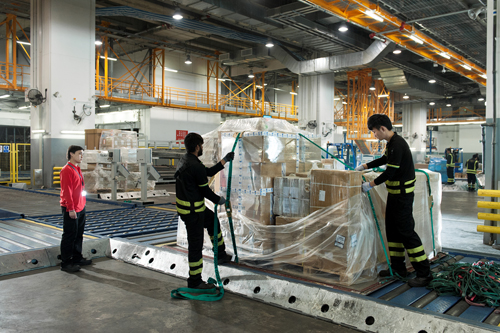With passenger ops in doldrums, Cathay turns to cargo for good news
First came the Persian Gulf and mainland Chinese carriers. Then the low-cost competition kicked in. Yesterday, Cathay Pacific posted its worst first-half loss in at least two decades as it continues to lose passengers to its rivals. With no improvement in conditions expected this year, cargo was the only bright spot in Cathay Pacific’s otherwise dismal first-half report, which reported a loss of US$262.07 million, year-over-year, for the six months ended June 2017.
Cathay’s new CEO Rupert Hogg has undertaken a three-year restructuring plan to revive the airline’s fortunes, which has already resulted in the loss of 600 jobs. And while those cuts haven’t translated into profits on the passenger side, Hogg was optimistic about the Hong Kong-based carrier’s cargo operations. “The outlook for the cargo business is good, and we expect robust demand and growth in cargo capacity, yield and load factor in the second half of this year,” he said.

Cargo tonnage grew ahead of capacity, driven by strong exports from mainland China, particularly on trans-Pacific routes. Tonnes carried for the first-half increased 11.5 percent, y-o-y, to 966,000 tonnes. Load factors improved to 66.2 percent, compared with 62.2 percent in the same period 2016.
Alongside Cathay, other Hong Kong International Airport cargo handlers, such as Hactl, have reported a bumper year.
Cathay’s joint business agreement with Lufthansa Cargo between Hong Kong and Europe that started in February 2017 has also increased cargo revenues, the carrier said. With the peak season just getting started, Cathay said it stands to continue this trajectory. A strategic partnership with Atlas Air that got underway in June 2017 should provide additional capacity and access to markets, the carrier added.
Cargo yields were also improving, according to the H1 report, after falling from US$0.32 per revenue tonne kilometer (RTK) in 2011, they have recovered to $0.21 per RTK so far this year.
Sometime in February 2017, Cathay Pacific’s load factors pulled ahead of the figures from the previous four years, and with forwarders warning of under-capacity, carriers like Cathay appear to be well-positioned to capitalize on this trend.
Ronald Lam, who was just named the carrier’s first director of commercial and cargo, said that, “Cargo will remain as an important revenue generator and contributor to the overall general airline business.” Lam added that he would lead a renewed focus on cargo, given its importance to the carrier’s bottom line.
To learn more about future innovations in freight forwarding, air freight and logistics, join us at Air Cargo World’s ELEVATE Conference in Miami, Oct. 2. Click here for registration information.





